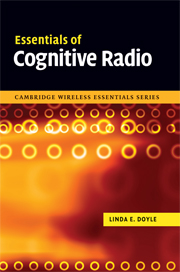Book contents
- Frontmatter
- Contents
- Acknowledgments
- List of abbreviations
- 1 A cognitive radio world
- 2 The essentials – an overview
- 3 Taking action
- 4 Observing the outside world
- 5 Making decisions
- 6 Security in cognitive radio
- 7 Cognitive radio platforms
- 8 Cognitive radio regulation and standardisation
- 9 Conclusions
- Appendix A Developments in the TV white spaces in the USA
- Index
3 - Taking action
Published online by Cambridge University Press: 10 August 2009
- Frontmatter
- Contents
- Acknowledgments
- List of abbreviations
- 1 A cognitive radio world
- 2 The essentials – an overview
- 3 Taking action
- 4 Observing the outside world
- 5 Making decisions
- 6 Security in cognitive radio
- 7 Cognitive radio platforms
- 8 Cognitive radio regulation and standardisation
- 9 Conclusions
- Appendix A Developments in the TV white spaces in the USA
- Index
Summary
Introduction
We are by now well acquainted with the ‘observe, decide, act’ cycle. This chapter is the first of three core chapters that relates to the cycle and focuses on the act part. ‘Taking action’ was introduced in the last chapter as ‘the setting of the various knobs on the radio’. So we have already been introduced to the idea that there are a large number of possible knobs such as frequency, bandwidth, signal duration, modulation technique, power, etc. that can be set, but we have not looked at any details. In this chapter we look at the details and more explicitly at what actions are needed for the kinds of applications described in the opening chapter of this book.
To do this we need first of all to further build our knowledge about what actions are possible. A second important point of this chapter is to develop an understanding of the consequences of the actions taken. While we have stressed in the previous chapter that ‘taking action’ is not just about the physicality of the transmitted signal and can pertain to other aspects of the communication process such as higher-layer performance issues, management of battery lifetime of the node or the processing resources of the node, it is the physical interaction of the transmitted signal with other entities around it that is core to understanding the consequences of the actions that are taken.
Information
- Type
- Chapter
- Information
- Essentials of Cognitive Radio , pp. 47 - 88Publisher: Cambridge University PressPrint publication year: 2009
